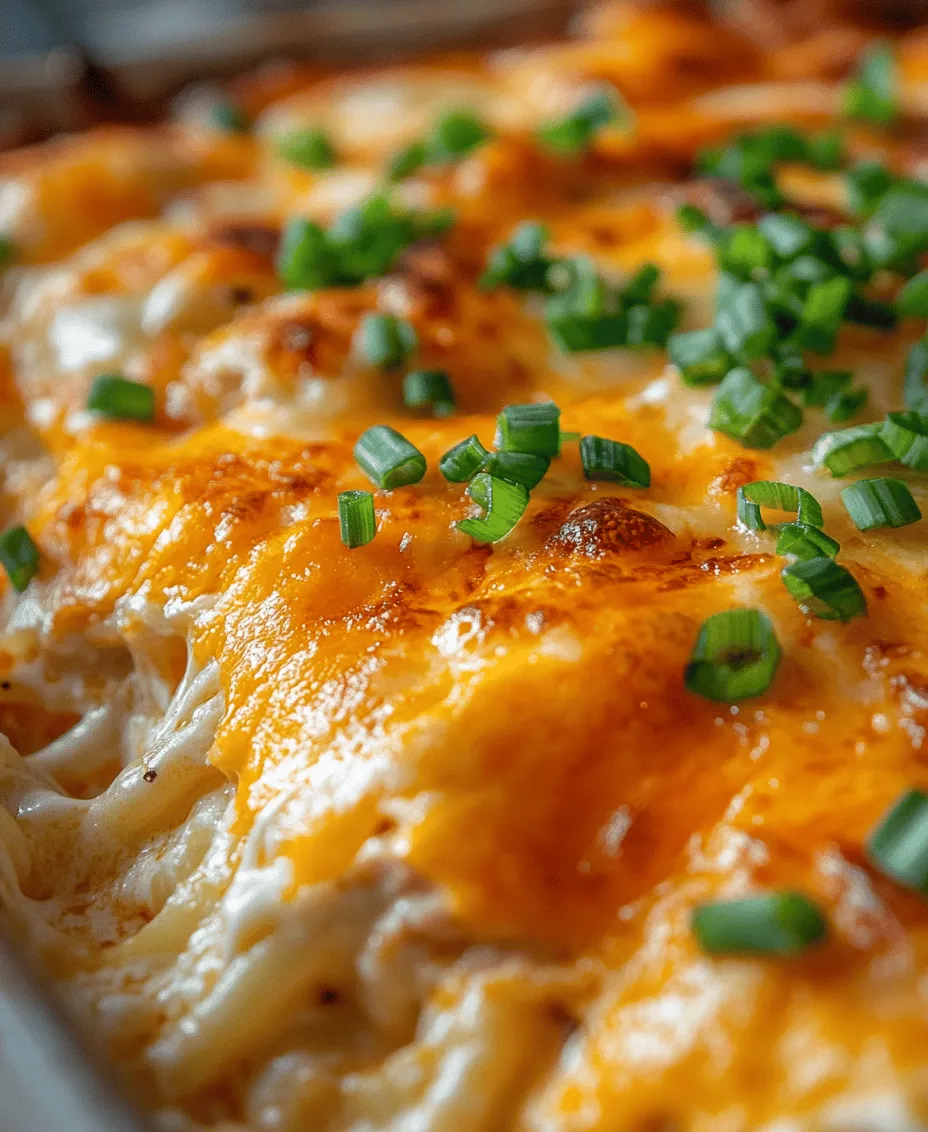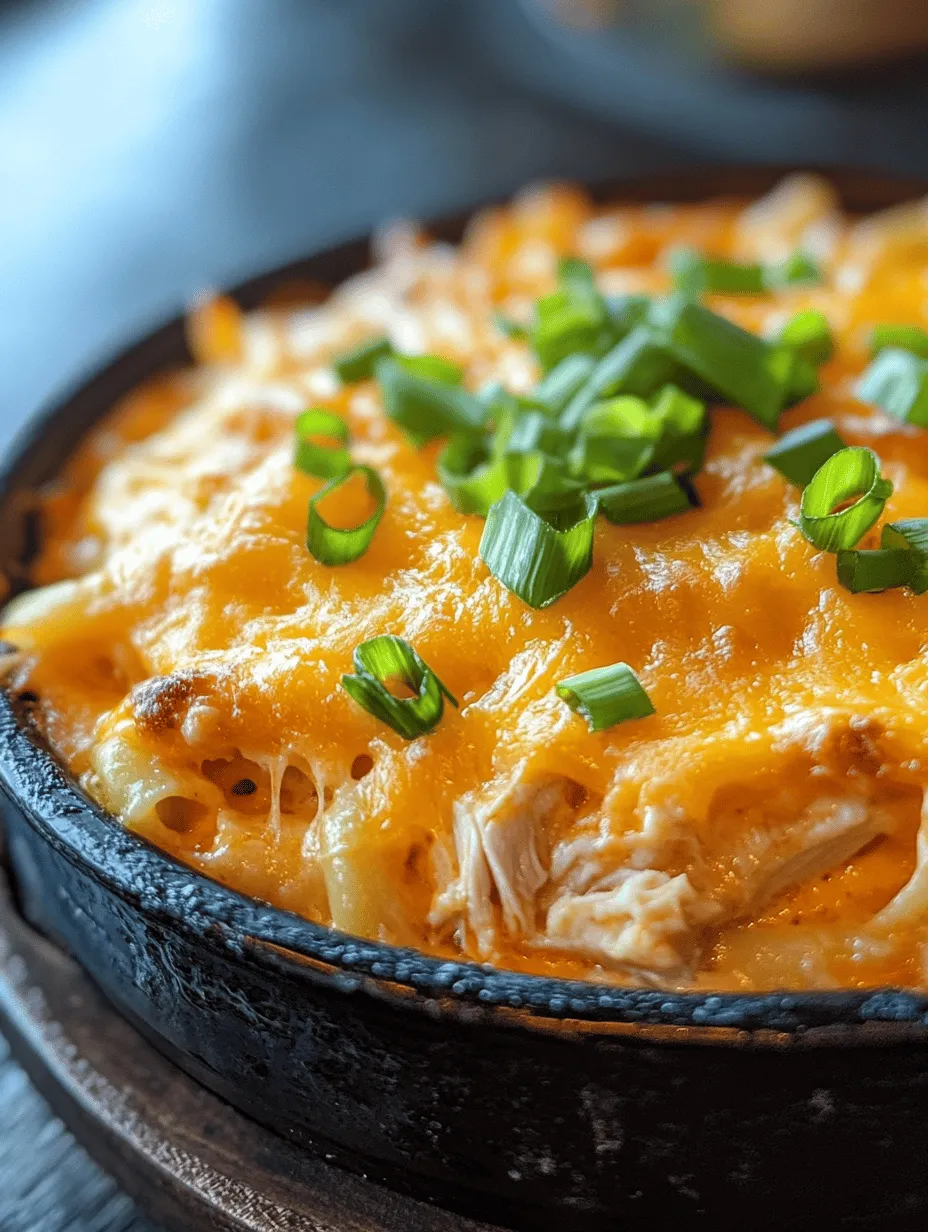Introduction
Buffalo Chicken Mac and Cheese is not just a meal; it’s an experience that brings together the rich, creamy comfort of classic macaroni and cheese with the fiery zest of buffalo chicken. This dish has gained immense popularity over the years, becoming a go-to comfort food that’s perfect for various occasions. Whether you’re hosting a family gathering, preparing for the big game day, or simply looking for a cozy meal to enjoy at home, this recipe is sure to impress.
The origins of Buffalo Chicken Mac and Cheese can be traced back to the fusion of two beloved American classics: mac and cheese, with its velvety cheese sauce and tender pasta, and buffalo chicken, known for its bold flavors and spicy kick. The combination of these two favorites results in a dish that is not only satisfying but also packed with flavor. Each bite delivers a creamy texture complemented by the heat of buffalo sauce, making it a delightful addition to any table.
In this article, we will delve into the essential ingredients that make up this scrumptious dish, provide you with step-by-step cooking instructions, and explore some variations to suit your taste. Whether you’re a seasoned chef or a beginner in the kitchen, this comprehensive guide will help you create the ultimate Buffalo Chicken Mac and Cheese that your family and friends will rave about.
Understanding the Ingredients
Creating the perfect Buffalo Chicken Mac and Cheese starts with understanding the key ingredients that contribute to its unique flavor and texture. Let’s take a closer look at each component.
Elbow Macaroni: The Classic Choice
Elbow macaroni is the quintessential pasta choice for mac and cheese, known for its distinctive shape and ability to hold onto the creamy cheese sauce. The small, curved tubes allow for maximum cheese coverage, ensuring that every bite is packed with flavor. The texture of elbow macaroni, with its al dente bite, complements the rich sauce beautifully.
If you’re looking for alternatives to elbow macaroni, consider using shell pasta, which has a similar ability to trap sauce, or penne, which provides a heartier bite. While these alternatives can change the dish’s texture slightly, they will still deliver a delicious result.
Shredded Cooked Chicken
The chicken is a crucial element of Buffalo Chicken Mac and Cheese, adding protein and heartiness to the dish. For convenience and flavor, using shredded rotisserie chicken is highly recommended. It saves time and offers a smoky, seasoned taste that enhances the overall dish.
If you prefer to cook chicken from scratch, you can poach, grill, or roast boneless chicken breasts or thighs. Simply season them with salt and pepper, cook until done, and then shred the meat. This option allows you to control the spices and flavors, tailoring the dish to your liking.
The Flavor Base: Spices and Sauces
The flavor profile of Buffalo Chicken Mac and Cheese is largely defined by the spices and sauces used. Key seasonings include garlic powder, onion powder, and smoked paprika. These spices add depth and warmth to the dish, enhancing the overall flavor without overpowering it.
Buffalo sauce is the star of the show, providing the signature kick that makes this dish so irresistible. When selecting a buffalo sauce, choose one that matches your heat preference. If you’re adventurous, you can even make your own buffalo sauce by mixing hot sauce, melted butter, and a splash of vinegar for acidity.
The Creamy Cheese Sauce
The cheese sauce is what truly elevates Buffalo Chicken Mac and Cheese to its creamy, indulgent glory. To create a rich and velvety sauce, you’ll start by making a roux—a mixture of butter and flour cooked together. This step is essential as it thickens the sauce and provides a smooth texture.
Using whole milk is crucial for achieving that creamy consistency. It adds richness and helps the cheese melt beautifully. When it comes to cheese, the classic combination of sharp cheddar and creamy mozzarella works wonders. Sharp cheddar provides a robust flavor, while mozzarella adds creaminess. For an additional tang, consider crumbling some blue cheese into the mix, which complements the buffalo sauce perfectly.
Step-by-Step Cooking Instructions
Now that you have a solid understanding of the ingredients, let’s dive into the cooking process. Here’s how to prepare your Buffalo Chicken Mac and Cheese from start to finish.
Cooking the Pasta
1. Boil Water: Start by filling a large pot with water and bringing it to a rolling boil. Add a generous amount of salt to the water—this is your chance to season the pasta.
2. Add Elbow Macaroni: Once the water is boiling, add the elbow macaroni. Stir occasionally to prevent sticking and cook according to the package instructions until al dente, usually around 7-8 minutes.
3. Drain and Rinse: After cooking, drain the macaroni in a colander. To prevent the pasta from becoming mushy later, rinse it briefly under cold water. This stops the cooking process and removes excess starch.
4. Set Aside: Once drained, set the pasta aside while you prepare the buffalo chicken mixture and cheese sauce.
Preparing the Buffalo Chicken Mixture
1. Sauté the Chicken: In a large skillet, heat a tablespoon of oil over medium heat. If you’re using shredded rotisserie chicken, simply add it to the skillet. If you’re cooking chicken from scratch, add your seasoned chicken and sauté until cooked through.
2. Add Spices and Sauce: Once the chicken is cooked, sprinkle garlic powder, onion powder, and smoked paprika over the meat. Pour in the buffalo sauce to taste, stirring to ensure the chicken is well coated. Cook for an additional 2-3 minutes until heated through.
3. Combine with Pasta: Once the chicken mixture is ready, add the cooked macaroni to the skillet. Stir to combine, allowing the flavors to meld together while you prepare the cheese sauce.
Crafting the Cheese Sauce
1. Make the Roux: In a medium saucepan, melt 4 tablespoons of butter over medium heat. Once melted, sprinkle in 4 tablespoons of flour, whisking continuously for about 1-2 minutes until the mixture is lightly golden.
2. Add Milk: Gradually pour in 3 cups of whole milk while whisking to avoid lumps. Continue to cook, stirring frequently, until the mixture thickens and begins to bubble, about 5-7 minutes.
3. Incorporate the Cheese: Remove the saucepan from heat and add in 2 cups of shredded sharp cheddar cheese and 1 cup of shredded mozzarella cheese. Stir until fully melted and combined. If you’re adding blue cheese, crumble it in at this stage for an extra punch of flavor.
4. Combine Everything Together: Pour the cheese sauce over the buffalo chicken and macaroni mixture in the skillet. Stir well to ensure every piece of pasta and chicken is enveloped in that creamy goodness.
By following these steps, you are well on your way to creating a mouthwatering Buffalo Chicken Mac and Cheese. This dish is not just about feeding the stomach; it’s about feeding the soul with its comforting flavors and textures. In the next section, we will discuss tips for achieving the best results and explore some delicious variations to this classic comfort food.

Techniques for Ensuring a Smooth, Lump-Free Cheese Sauce
Creating a velvety smooth cheese sauce is the cornerstone of any great mac and cheese recipe, especially when it involves the bold flavors of Buffalo chicken. Here are some key techniques to ensure your cheese sauce comes out perfectly every time:
1. Use the Right Cheese: Choose cheeses that melt well, such as sharp cheddar, Monterey Jack, or a combination of both. Pre-shredded cheese often contains anti-caking agents that can affect the smoothness of your sauce, so shredding your cheese fresh is recommended.
2. Temperature Matters: Start with room temperature ingredients. If your cheese is cold, it may clump when added to the sauce. Allow your cheese to sit out for 30 minutes before you begin cooking.
3. Make a Roux: Begin your cheese sauce with a roux (a mixture of equal parts fat and flour cooked together). This thickens the sauce and helps create a creamy texture. Whisk the flour into melted butter over medium heat until it’s a light golden brown, which usually takes about 1-2 minutes.
4. Gradual Addition of Milk: Slowly whisk in warm milk to the roux, ensuring there are no lumps. Whisk continuously while bringing the mixture to a simmer until it thickens.
5. Melt Cheese Over Low Heat: Once the milk mixture has thickened, reduce the heat to low and gradually add your shredded cheese. Stir gently until melted and smooth. Avoid high heat, which can cause the cheese to become stringy rather than creamy.
Combining Ingredients
Once your cheese sauce is silky and smooth, it’s time to combine it with the pasta and chicken. Here are some best practices to follow:
1. Cook Pasta Al Dente: Follow the package instructions for cooking your pasta, but aim for al dente. The pasta will continue to cook slightly when combined with the hot cheese sauce, so undercooking it a little ensures it doesn’t become mushy.
2. Mixing the Ingredients: In a large mixing bowl, combine the cooked pasta, shredded chicken, and cheese sauce. Use a spatula or wooden spoon to gently fold the ingredients together. This ensures that every piece of pasta is coated in delicious cheese sauce without breaking the pasta.
3. Achieving the Perfect Consistency: If the mixture seems too thick, add a bit more milk or reserved pasta water to loosen it. The goal is a creamy, cohesive dish that isn’t dry or overly runny.
Optional Baking Process
Baking your Buffalo Chicken Mac and Cheese is an optional step but one that can elevate the dish with added flavor and texture.
1. Why Bake?: Baking the dish allows the flavors to meld together and gives the top a delightful crispy texture. This step can enhance the overall experience, providing a contrast between the creamy interior and the crunchy topping.
2. Instructions for Baking:
– Preheat your oven to 350°F (175°C).
– Transfer the combined pasta, chicken, and cheese sauce into a greased baking dish (approximately 9×13 inches).
– For an extra crunchy topping, sprinkle breadcrumbs, crushed tortilla chips, or additional shredded cheese over the top before baking.
– Bake for 20-25 minutes or until the top is golden brown and bubbling. If you want an extra crispiness, broil for an additional 2-3 minutes, keeping a close eye to prevent burning.
Serving Suggestions
Garnishes That Elevate Your Dish
Garnishing your Buffalo Chicken Mac and Cheese can take it from ordinary to extraordinary. Here are some ideas:
– Chopped Green Onions: Adding freshly chopped green onions provides a pop of color and a mild, oniony bite that complements the richness of the dish.
– Crushed Red Pepper Flakes: For those who enjoy a kick, sprinkle some crushed red pepper flakes on top before serving to enhance the heat.
– Fresh Parsley or Cilantro: A sprinkle of chopped parsley or cilantro can add a fresh, herbaceous note to the dish, balancing its richness.
Pairing Ideas
To create a well-rounded meal, consider pairing your Buffalo Chicken Mac and Cheese with complementary side dishes and beverages:
– Side Dishes: A simple green salad with a tangy vinaigrette can cut through the richness of the mac and cheese. Alternatively, serving it with roasted vegetables or coleslaw can add texture and freshness to your meal.
– Beverage Pairings: A light beer, such as a lager or pale ale, pairs wonderfully with the spicy flavors of buffalo chicken. If you prefer wine, a crisp Sauvignon Blanc or a fruity Riesling can work well to balance the dish’s richness.
Variations on the Classic Recipe
Buffalo Chicken Mac and Cheese is versatile, allowing for many variations to suit different tastes and dietary needs.
Spicy Alternatives
For those who crave extra heat, consider incorporating additional spicy elements:
1. Add Jalapeños: Diced fresh or pickled jalapeños can be mixed into the pasta for an extra layer of flavor and heat.
2. Adjusting the Sauce: You can easily modify the buffalo sauce amount to cater to different spice levels. If you want a milder dish, reduce the amount of buffalo sauce and substitute some with ranch dressing for a creamy finish.
Healthier Swaps
If you’re looking to make this dish a bit healthier, here are some options:
1. Light Cheese and Pasta Alternatives: Use whole wheat pasta or gluten-free pasta and opt for lighter cheeses, such as part-skim mozzarella or reduced-fat cheddar, to reduce calories.
2. Incorporating Vegetables: Adding vegetables like spinach, broccoli, or cauliflower can boost the nutritional value without sacrificing flavor. Simply steam or sauté the vegetables before mixing them into the pasta.
Dietary Considerations
Making Buffalo Chicken Mac and Cheese accessible for various dietary needs is possible with a few substitutions:
1. Gluten-Free Version: Use gluten-free pasta and check the buffalo sauce for gluten-containing ingredients. Most hot sauces are naturally gluten-free, but it’s always best to double-check.
2. Dairy-Free Alternatives: Substitute regular cheese with dairy-free cheese options or nutritional yeast for a cheesy flavor. Use plant-based milk such as almond or oat milk for the sauce, and ensure your buffalo sauce is dairy-free.
Conclusion
Buffalo Chicken Mac and Cheese is a delightful fusion of comfort food and bold flavors, making it a hit for both casual dinners and special gatherings. This recipe provides a rich, creamy base, combined with the heat of buffalo sauce and the heartiness of chicken. The step-by-step instructions ensure that anyone, from novice cooks to seasoned chefs, can confidently create this dish.
The versatility of Buffalo Chicken Mac and Cheese allows for endless customization, whether you prefer sticking to the traditional recipe or exploring spicy alternatives and healthier substitutions. Garnishing your dish and pairing it with thoughtful sides and beverages can elevate your dining experience further.
With its satisfying flavors and textures, this recipe is sure to impress family and friends alike. Embrace the creamy goodness and the spicy kick, and enjoy the pleasure that comes from creating a dish that truly delights the senses. Whether it’s a cozy family meal or a gathering with friends, Buffalo Chicken Mac and Cheese is destined to become a beloved staple in your culinary repertoire.



